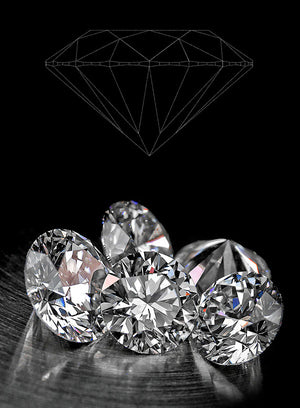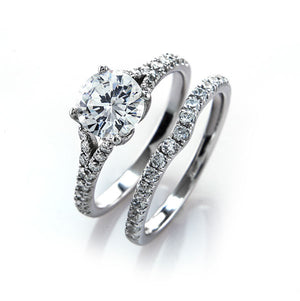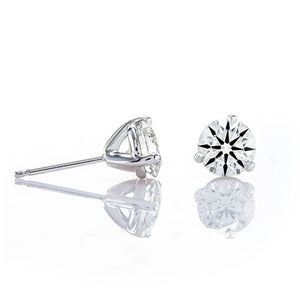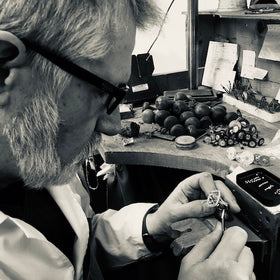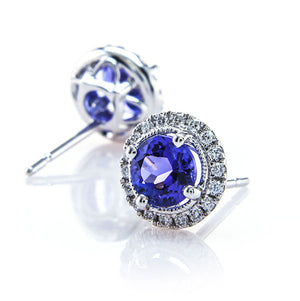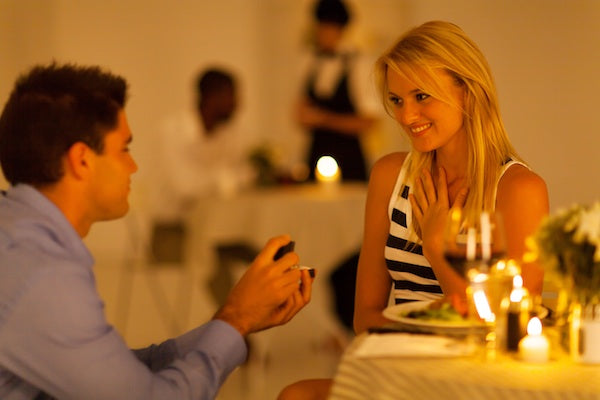
Is Moissanite more brilliant than diamond?
“I’m in the process of researching diamonds for an engagement ring and and ran across a web site that claims that moissanite is the most brilliant gem; I’ve always thought that diamond was the most brilliant gem, is moissanite more brilliant than diamond? And if so, why does it seem like diamonds are more popular than moissanite for engagement rings? Based upon what I’ve read, moissanite is as hard and durable as diamond, and it is less expensive in price, so it seem like the perfect choice for an engagement ring; is there a reason why I should purchase a Brian Gavin Signature diamond instead of choosing moissanite as a center stone?”
Synthetic moissanite vs natural diamond for e-ring:
Without a doubt, there is a viable market for gemstones of all types, including those which are natural, simulated, and synthetic, but our focus at Brian Gavin Diamonds is on natural diamonds, which is why we do not actively market moissanite as an option.
The “gem” which is commonly referred to as moissanite has kind of an interesting history, according to Wikipedia the mineral moissanite was originally discovered by Henri Moissan in 1893, when he was examining rock samples that were taken from a meteor crater in Canyon Diablo, Arizona.
Initially Moissan apparently thought that the pieces of mineral that he discovered were diamond particles, however nine years after making the initial discovery, he determined that the crystals were silicone carbide.
Naturally occurring moissanite is quite rare, it has only been discovered within the outer crust of meteorites. Synthetic moissanite that is man made, and commonly referred to as lab created moissanite, was introduced to the jewelry market in the late 1990’s. This rendition of “moissanite” has been marketed as an alternative to diamonds, with some optical properties being better than diamond, however we feel that this is a bit of a stretch to say the least.
Is moissanite better than diamond?
One of the reasons that proponents of synthetic moissanite say that moissanite is better than diamond, is that it is supposed to be more brilliant than diamond… however the use of the term brilliance tends to be a bit misunderstood by the average diamond buyer.
The term “brilliance” refers not only to the volume of light return, but also the degree to which the diamond exhibits white light, as opposed to colored light, which is commonly referred to as dispersion, because it occurs when our eyes disperse white light into spectral hues.
The majority of gemstones manufactured from lab created moissanite are faceted with a facet structure that differs from a standard round brilliant cut diamond, like those featured within the Brian Gavin Signature collection of round diamonds, and from what we’ve seen give off a type of sparkle that looks more like crushed ice than the type of sparkle exhibited by a properly proportioned, properly faceted round brilliant cut diamond.
While moissanite is technically 2.4 more dispersive than diamond, the dispersion which it casts off has that kind of a chemical based, artificial feel to it, I don’t know how else to describe it, but it just doesn’t compare to the broad spectrum, bright, brilliant, flashes of fire exhibited by diamond… but perhaps I’m biased, we tend to be attracted to what we’re accustomed to and I happen to be in the diamond business.
Another point of confusion regarding the difference between diamonds and moissanite is based upon the color or tone of moissanite as it compares to natural diamond. Generally speaking, the majority of lab created moissanite is marketed as being white or near colorless, which tends to fall in the range of I-J-K on the color grading scale for diamonds, however moissanite can also appear to be more yellow or even grey in color, which might be one of the reasons why early advertisements for moissanite indicated that it fooled some jewelers, but we’ve never seen one which fooled us, the difference between diamond and lab created moissanite is rather apparent to an experienced diamond grader.
Is diamond or moissanite harder / more durable?
The relative hardness of moissanite on the Moh’s Hardness Scale is 9.5 which falls between diamond which is a ten, and sapphire / ruby which is a nine, making it more durable than ruby or sapphire, but less durable than diamond… but this of course is all relative, because at the end of the day, the relative hardness of a gemstone is based upon whether it will withstand the pressure of being rubbed up against another gemstone, which simply means that diamond will scratch moissanite, and moissanite will scratch ruby or sapphire, but they can all be damaged if pressed up against something harder.
Setting the technical details that differentiate natural diamond from lab grown, synthetic moissanite aside, the reality is that in my experience most women want the center stone in their engagement ring to be real, they view it as a symbol of the love which exists between the two of you, and they don’t want anything in their ring to be grown in a laboratory, which perhaps is why moissanite is no more popular than synthetic cubic zirconia, or any of the other diamond simulants that have ventured in and out of popularity over the course of time.
Should you disclose that the center stone is moissanite?
I think that it goes without saying that you should disclose that the center stone in the engagement ring that you present your bride-to-be is a lab grown moissanite if you decide to go that route, because people do not like to be misled or deceived.
I watched a young woman burst into tears inside a jewelry store one day when she brought her “diamond engagement ring” in to be cleaned and polished, only to be told by the jeweler that the center stone in her ring was not a diamond; all of this occurred at the front counter, before the jeweler took possession of the ring. I imagine that her fiancé thought that the stone looked just like a diamond, or would be good enough, but her disappointment was clear.





